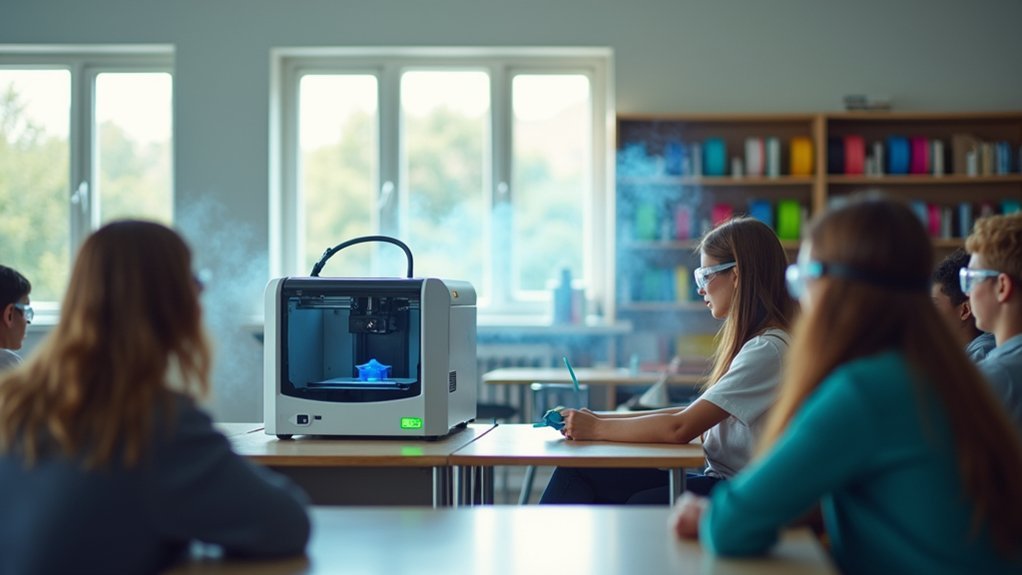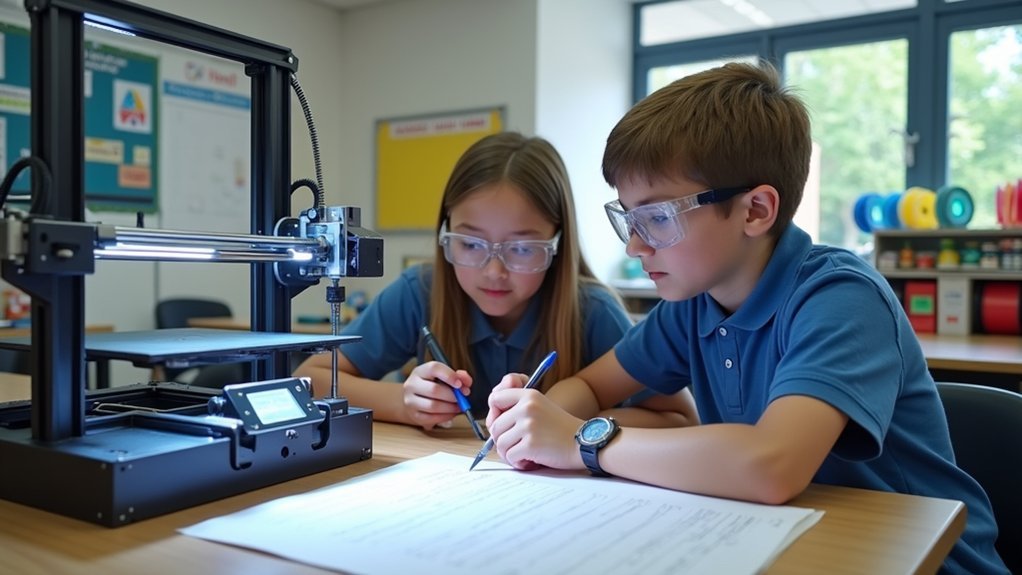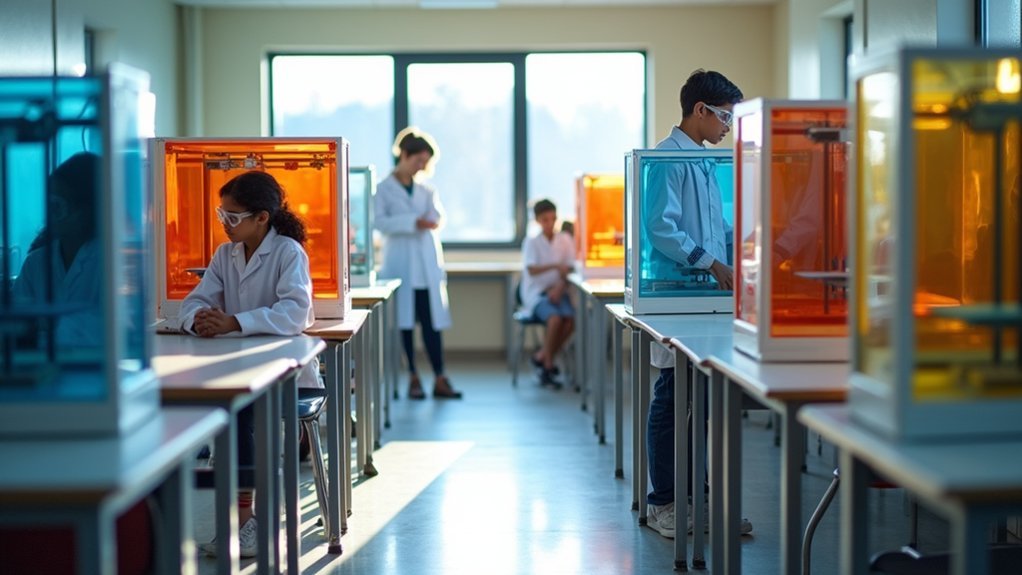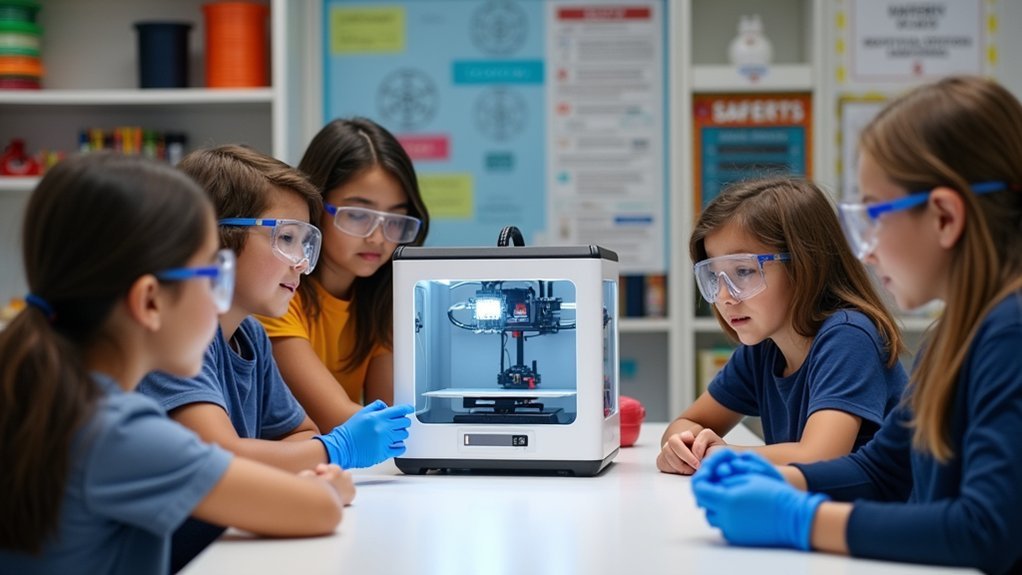You’ll need proper ventilation systems with HEPA filters and charcoal beds to remove dangerous VOCs and ultrafine particles from your printing areas. Establish thorough material handling protocols with clear labeling and PPE requirements for students. Implement regular equipment inspections and mandatory safety training covering emission risks and emergency procedures. Install physical barriers and enclosures around printers with automated safety shutoffs. Monitor air quality consistently and develop proper waste disposal procedures for hazardous materials. These protocols will protect your students’ long-term health.
Ensure Proper Ventilation and Air Quality Control

While 3D printers offer incredible educational opportunities, they also release potentially harmful emissions that require your immediate attention.
3D printers provide amazing learning experiences but emit dangerous fumes that demand your urgent safety response.
You’ll need to establish adequate ventilation to remove volatile organic compounds (VOCs) and ultrafine particles (UFPs) from your printing area.
Position your 3D printers in a well-ventilated area near openable windows or install dedicated exhaust systems. You should also consider enclosed setups with filtration systems that direct fumes outdoors.
Installing HEPA filters with charcoal beds effectively absorbs VOCs and improves overall air quality.
Don’t forget to monitor your air quality regularly, ensuring VOC and UFP levels stay within safe limits.
These ventilation measures will protect your students and staff from harmful emissions while maintaining a healthy learning environment.
Establish Comprehensive Material Handling Protocols
Beyond ventilation concerns, you must develop clear protocols for how students handle, store, and dispose of 3D printing materials. Establish thorough training programs that educate students about specific health risks associated with different materials. Provide personal protective equipment like gloves and masks when handling hazardous materials in educational settings.
| Material Type | Safety Requirements | Handling Procedures |
|---|---|---|
| PLA Filament | Minimal PPE needed | Standard ventilation |
| ABS Filament | Gloves, masks required | Enhanced ventilation |
| Resin Materials | Full PPE mandatory | Specialized disposal |
Implement a labeling system displaying safety data sheets for all materials. Schedule regular training sessions covering handling procedures and emphasizing safety protocols. Your thorough approach guarantees students make informed material choices while maintaining proper safety standards throughout the 3D printing process.
Implement Regular Equipment Maintenance and Inspection

You’ll need to establish a systematic approach to equipment maintenance that includes both daily inspections and scheduled upkeep protocols.
Before each use, check your 3D printers for worn belts, damaged nozzles, and any visible mechanical issues that could create safety hazards.
Create a regular maintenance schedule that covers cleaning procedures, component inspections, and dust removal to keep your equipment running safely and efficiently.
Daily Pre-Use Inspections
Daily pre-use inspections form the foundation of safe 3D printing operations in educational environments.
You’ll need to conduct these maintenance checks before each printing process to identify potential issues and guarantee your 3D printers operate safely. Check for loose connections, damaged components, or clogged nozzles that could cause mechanical failures and prevent accidents.
Clean the build plate regularly, removing debris and filament remnants to maintain ideal conditions and reduce fire risks. Document your inspection results to track performance trends requiring attention.
Incorporate students into these daily pre-use inspections to build safety awareness and responsibility. Verify proper ventilation functions correctly during inspections, and always follow established safety guidelines to maintain a secure learning environment for everyone involved.
Scheduled Maintenance Protocols
While daily inspections catch immediate problems, thorough scheduled maintenance protocols protect your equipment and students over the long term.
Regular maintenance checks should occur weekly or monthly depending on printer usage. These safety protocols require documenting maintenance activities to track performance and guarantee compliance with safety standards.
Always observe a proper cooling-off period before servicing hot printer components to prevent burns.
Scheduled inspections help identify wear and tear on critical parts before they cause mechanical failures. Clean nozzles and build plates thoroughly, removing accumulated filament to prevent malfunctions.
- Check belts, pulleys, and motors for signs of wear or unusual noise
- Inspect electrical connections and cables for damage or loose fittings
- Lubricate moving parts according to manufacturer specifications to maintain smooth operation
Provide Mandatory Safety Training for Students and Staff
Since 3D printers pose unique safety challenges in educational settings, establishing mandatory safety training for both students and staff becomes vital for preventing accidents and health risks.
You’ll need to implement thorough training programs that cover proper personal protective equipment usage and awareness of volatile organic compounds and ultrafine particles released during printing operations.
Your training should address critical ventilation requirements and material handling procedures to minimize exposure risks.
Proper ventilation systems and careful material handling are essential for reducing harmful exposure during 3D printing activities.
Staff members require specialized instruction on standard safety protocols to guarantee consistent 3D printing safety practices across your institution.
You should collaborate with safety organizations to access current resources and best practices.
Regular training updates keep everyone informed about emerging hazards and proper disposal methods, creating a safer educational environment for all participants.
Install Physical Safety Barriers and Enclosures

Beyond thorough training programs, you must implement physical safety barriers and enclosures around your 3D printers to create multiple layers of protection in educational environments.
Installing these safety barriers effectively contains harmful emissions and prevents students from accidentally contacting moving parts during operation. Properly designed enclosures greatly reduce exposure to volatile organic compounds and ultrafine particles that pose serious health risks.
Enhanced ventilation systems work more efficiently when directing fumes away from the printing area through enclosed setups. These physical barriers also serve as visual reminders for students to maintain safe distances from operating equipment.
- Enclosed printer stations with clear viewing panels allow observation while containing emissions
- Ventilation ducting integrated into enclosures directs harmful fumes outside classroom spaces
- Automated safety shutoffs triggered when enclosure doors open during printing operations
Monitor for Emissions and Particle Exposure
You’ll need to actively monitor your 3D printing environment for harmful emissions that can seriously impact student and staff health.
Understanding ultrafine particle (UFP) risks, implementing effective VOC detection methods, and utilizing proper air quality monitoring tools are essential for maintaining a safe learning space.
These monitoring practices aren’t optional—they’re critical safety measures that protect everyone in your facility from potentially dangerous airborne contaminants.
Understanding UFP Health Risks
When 3D printers operate, they release ultrafine particles (UFPs) ranging from 1 to 100 nanometers that you can’t see but can easily inhale. These particles pose serious health risks in educational settings, particularly with prolonged exposure.
UFPs can trigger respiratory infections and worsen chronic conditions like asthma, potentially leading to COPD or lung cancer over time.
Understanding these health risks helps you implement proper safety measures:
- Immediate effects: UFPs can cause respiratory irritation, coughing, and breathing difficulties in students and staff.
- Long-term consequences: Chronic exposure may result in permanent lung damage and cardiovascular diseases.
- Vulnerable populations: Students with pre-existing conditions face heightened risks from poor air quality.
Prioritizing ventilation systems and air quality monitoring protects everyone in your 3D printing environment from these invisible but dangerous particles.
VOC Detection Methods
While UFPs present invisible dangers, Volatile Organic Compounds (VOCs) create another layer of air quality concerns that necessitate active detection and monitoring.
You’ll need air quality monitors that detect both VOCs and ultrafine particles in your printing area. These devices measure emission concentrations in real-time, alerting you when levels exceed safety standards.
Install monitors near 3D printers to track exposure during operations. Different filament materials produce varying VOC levels, making continuous monitoring essential in educational environments.
Combine detection with proper ventilation systems including exhaust fans and HEPA filters to maintain acceptable air quality.
Schedule regular assessments to ascertain compliance with health guidelines. Understanding potential health risks like respiratory issues reinforces why you can’t rely on smell alone for detection.
Air Quality Monitoring Tools
Real-time monitoring equipment serves as your first line of defense against invisible airborne hazards in school makerspaces. Air quality monitoring tools detect volatile organic compounds (VOCs) and ultrafine particles (UFPs) that pose serious health risks during the printing process.
You’ll need to position these monitoring systems close to your 3D printers for accurate emissions tracking.
- Strategic placement: Install monitors within three feet of active printers to capture real-time VOC concentrations and particle levels
- Automated alerts: Configure systems to trigger warnings when emission thresholds exceed safe limits, prompting immediate ventilation adjustments
- Data integration: Connect monitoring data to your school’s safety protocols for documentation and trend analysis
These tools enable timely interventions that protect your learning environment while maintaining educational opportunities.
Develop Emergency Response and Waste Disposal Procedures
Although 3D printing technology offers tremendous educational benefits, you must prepare for potential emergencies and establish proper waste management protocols to maintain a safe learning environment.
Start by creating clear emergency procedures that address fires and chemical spills, ensuring everyone knows evacuation routes. Develop a thorough disposal policy covering hazardous substances like resins that require special handling methods.
Organize regular training sessions so students and staff understand potential risks and appropriate responses during incidents.
Establish clear labeling systems for waste containers, differentiating between hazardous and non-hazardous materials to reinforce proper disposal practices.
Partner with local waste management facilities to meet compliance regulations and promote recycling materials whenever possible, creating a sustainable approach to 3D printing safety.
Frequently Asked Questions
What Are the Safety Precautions for 3D Printers?
You’ll need proper ventilation to reduce harmful emissions, regular maintenance checks, protective equipment like gloves and safety glasses, strict no-food policies, and established emergency protocols for safe operation.
What Is an Essential Safety Precaution During the Removal of a 3D Printed Part?
You must allow the printed part to cool completely before removal. Hot components can cause serious burns, so wait until everything reaches room temperature before touching or handling the part.
What PPE Is Required for 3D Printing?
You’ll need safety goggles, nitrile gloves, and a respirator rated for organic vapors. Wear protective lab coats or long-sleeved clothing to prevent burns and chemical exposure during printing operations.
Is It Okay to Sleep in the Same Room as a 3D Printer?
You shouldn’t sleep in the same room as a 3D printer. The emissions of volatile organic compounds and ultrafine particles can cause respiratory issues, plus fire hazards increase overnight.





Leave a Reply